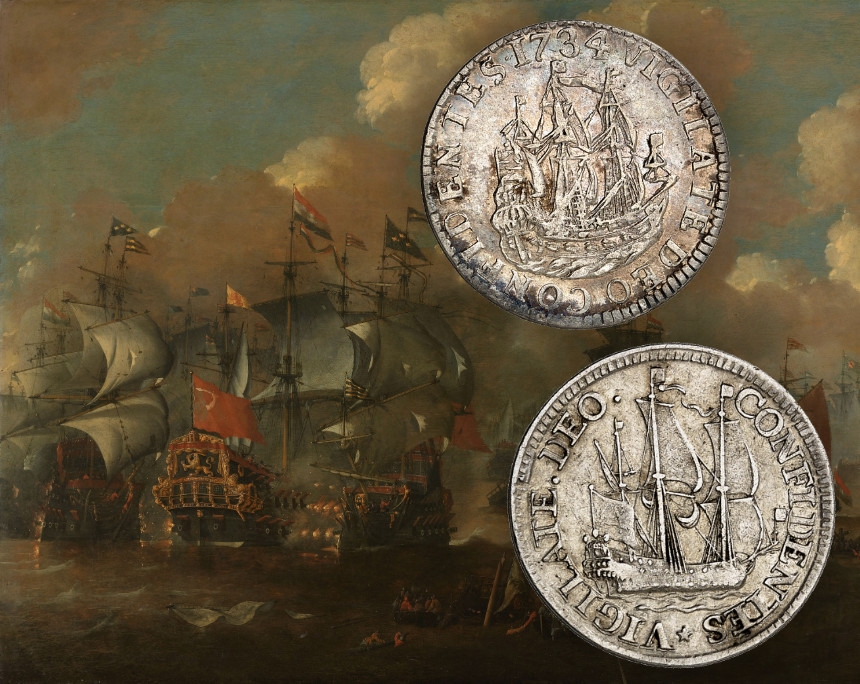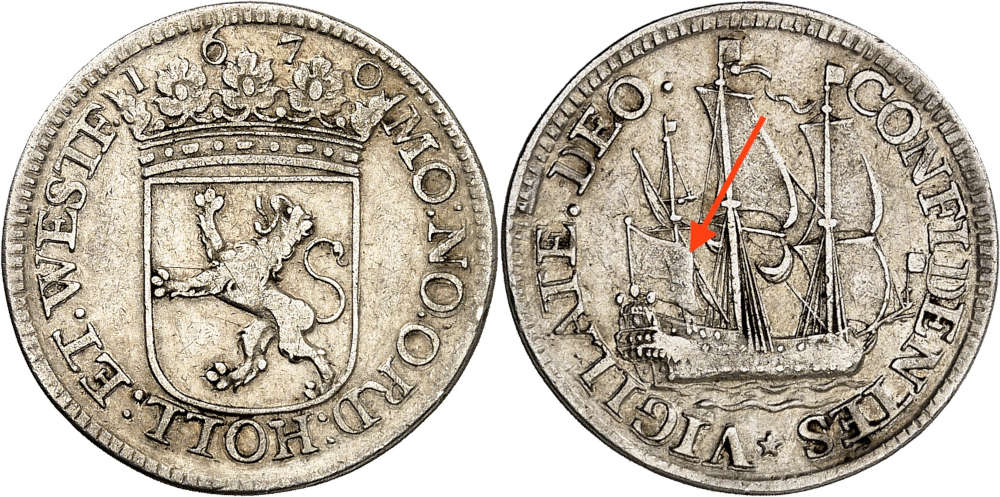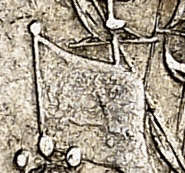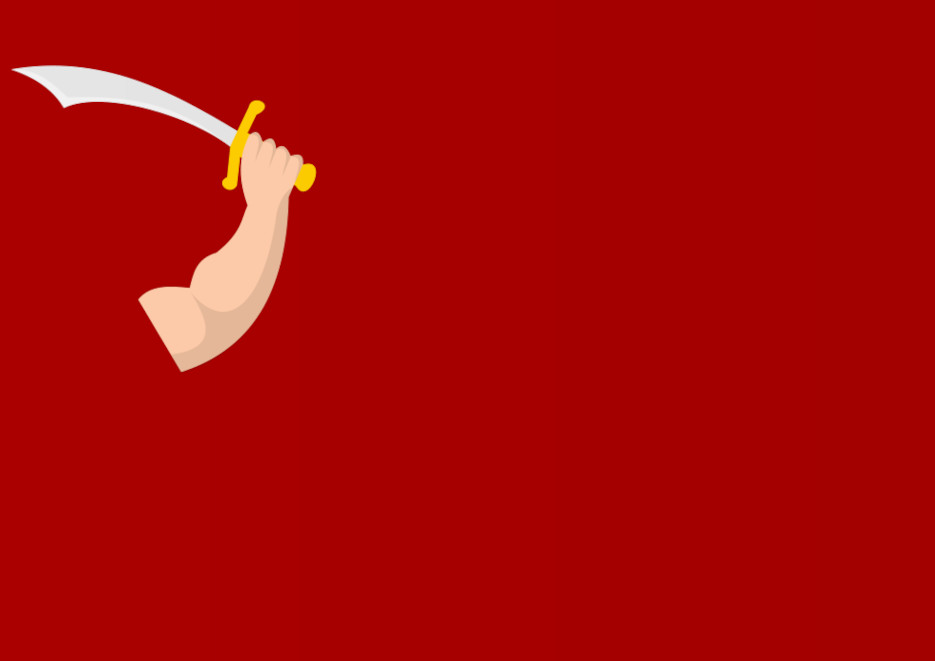Bloody Flag and Scheepjesschelling
On 27 and 28 September 2024, Künker will auction off part 2 of the Beuth Collection with Dutch coins in collaboration with Laurens Schulman. This important collection includes numerous rarities. But it also contains affordable coins with two-digit estimates that are just as fascinating as their unique and extremely rare counterparts, as we will prove in this article.
Content
On 9 November 1670, the States of Holland and West Frisia decided to introduce a new coin. In addition to all the low-value shillings that circulated in the domestic market, they wanted to create a reliable currency for foreign trade. After all, a coin’s fineness and weight were all that mattered abroad. So if you wanted to create a coin for long-distance trade, you would always use the same alloy and only allow the weight to vary slightly.
But the politicians of the States of Holland and West Frisia were not only smart economists. They also knew a lot about propaganda. Just how cleverly they approached this matter is illustrated by the coin type they decided to produce on 9 November 1670.
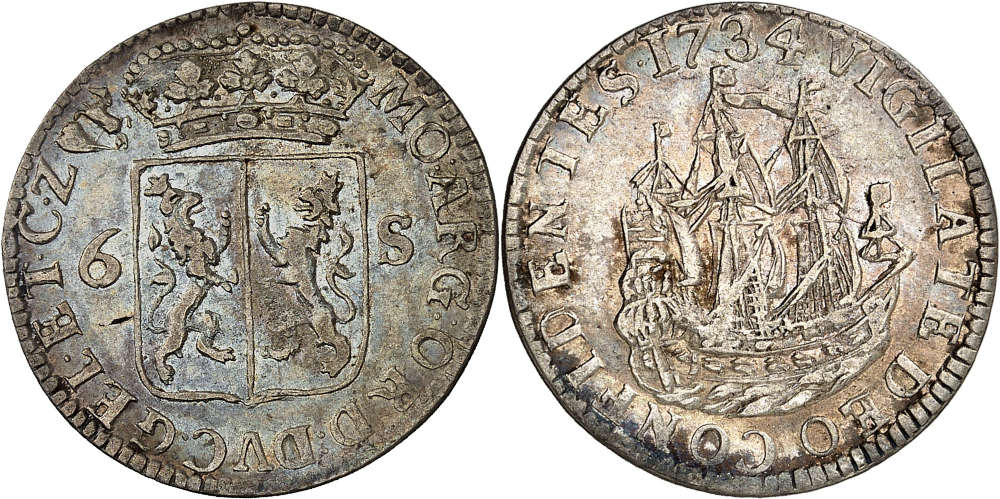
Netherlands / Gelderland. 1734 scheepjesschelling (6 stuivers), Harderwijk. Very fine to extremely fine. Estimate: 100 euros. From Künker 414 (27/28 September), No. 4149.
The Scheepjesschelling
The coin depicts an impressive sailing ship with the wind blowing in its sails. Given the fact that the Netherlands was a major player in overseas trade, this motif seems rather straightforward from today’s perspective. For contemporaries, however, the image was quite unusual. The Netherlands would normally rely on motifs that symbolized unity and / or freedom. Just think of the Phrygian cap or Scilurus’ bundle of arrows. A realistic depiction of a ship was something new and different.
The motif was to give the shilling its name. It is called scheepjesschelling, which translates to ‘little ship shilling’. Scheepje or little ship sounds like a harmless holiday boat. But what we can see on these shillings is anything but harmless. While today we struggle to distinguish early modern merchant ships from warships, people in the 17th century certainly knew the difference. They saw more than just the elegant sleek hull and the fluttering sails. They saw the cannons. Any contemporary looking at this motif would associate this type of ship with the fight for life and death.
De Bloedvlag
A very rare pattern of the scheepjesschelling without mint mark and face value on the obverse gives us another clue as to how this depiction should be interpreted. If you take a closer look at the flag at the stern of the ship, you will see that it is not the Prinsenvlag with the orange, white and blue stripes. It is a different flag, and the appearance of it is difficult to interpret without prior knowledge. It shows something that could be mistaken for a cross-shaped motif with a displaced center. But if you know what it is supposed to represent, you will be able to identify a blade held vertically that widens upwards, and a hand holding the hilt of the blade.
And this brings us to the bloody flag. It shows a muscular arm holding a cutlass against a bloody red background. Cutlasses were closely associated with seafaring. They were used for hand-to-hand combat on deck. These arms originated from the machete, a broad knife used for harvesting sugar cane, for example. The short, sturdy blade was ideal for dealing deadly blows in confined spaces. Therefore, it was the perfect weapon for anyone trying to board a ship.
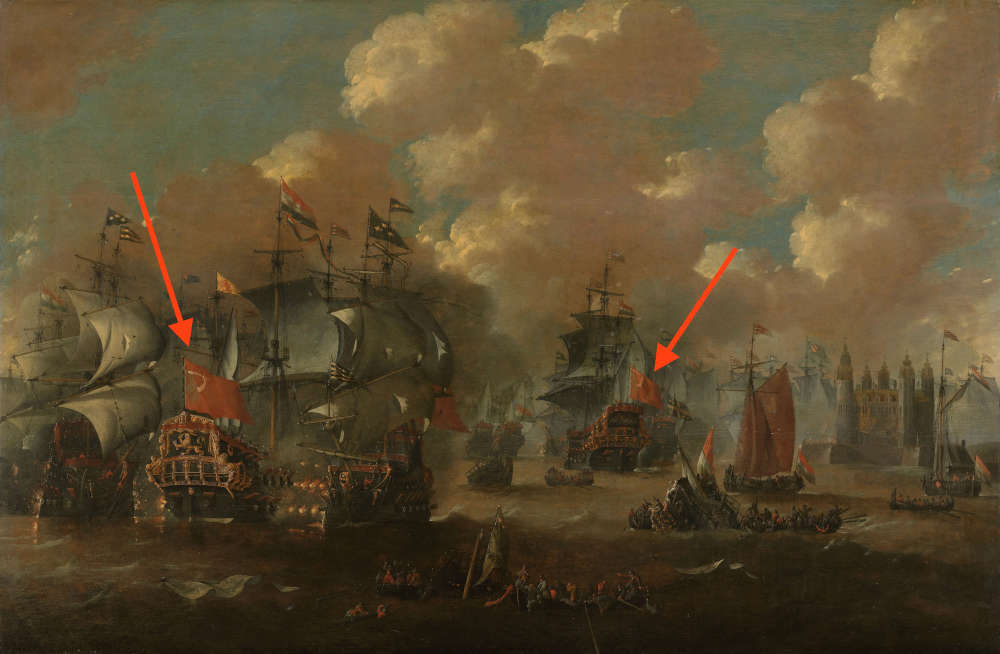
Naval battle near Elseneur. Painting by Peter van de Velde, created between 1670 and 1679, at the same time as the first scheepjesschellings.
Knowing about this weapon helps us understand the purpose of the bloody flag. It was used as a signal. It was hoisted to show that things were about to get serious. The bloody flag signaled an attack, whether in battle or in a duel on the high seas.
In other words: a coin devised for foreign trade depicting a ship with a bloody flag sent a clear message. But why was this necessary?
The Historical Background
Although the Republic of the Seven United Netherlands had asserted its independence with the Peace of Westphalia, this did not guarantee a peaceful existence. Dutch politicians were particularly concerned about the events in France. Philip IV of Spain died in 1665, leaving a three-year-old successor. Louis XIV of France seized the opportunity to expand his empire. He argued that his marriage to a daughter of the deceased gave him a claim to part of the inheritance. Naturally, the Spanish regent rejected his claim. But it was no use. The young and ambitious King of France went to war. After all, he had an expensive standing army, a strategic innovation at the time. And he wanted to use it. So, he invaded the Spanish Netherlands 1667. Spain was unable to react. France would have experienced a perfect victory had it not been for other states who wondered what France’s growing power meant for them. This led to England, Sweden and the Netherlands forming an alliance in 1668. The Netherlands, which had traditionally sided with France due to their shared enmity towards the Habsburgs, broke a treaty.
Louis XIV was furious. He had expected the Netherlands to uphold their alliance with France. In the Treaty of Aix-la-Chapelle, Louis XIV had to tone down his demands and return some of the conquered territories. This gave him a clear idea of whom he would wage his next war against: the Netherlands.
![Copy of a letter of marque and reprisal by Maurice of Nassau for Johan de Moor of 1 June 1618. Nationaal Archief, The Hague. Archieven van de Admiraliteitscolleges [nr. toegang 1.01.46] inv.nr 2425. Copy of a letter of marque and reprisal by Maurice of Nassau for Johan de Moor of 1 June 1618. Nationaal Archief, The Hague. Archieven van de Admiraliteitscolleges [nr. toegang 1.01.46] inv.nr 2425.](https://new.coinsweekly.com/wp-content/uploads/2024/09/2024KW38HA_06.jpg)
Copy of a letter of marque and reprisal by Maurice of Nassau for Johan de Moor of 1 June 1618. Nationaal Archief, The Hague. Archieven van de Admiraliteitscolleges [nr. toegang 1.01.46] inv.nr 2425.
Privateers and the Dutch Fleet
Louis XIV started to close in on the Netherlands both militarily and diplomatically. He broke their alliance with England and Sweden, and made treaties with neighboring princes. Of course, this did not go unnoticed in the Netherlands.
And this is where we come back to our scheepjesschelling. The coin reminded everyone of the true strength of the Netherlands – and that was not a standing army with countless soldiers, but all the ships that sailed the world’s oceans. The coin served as a reminder that any Dutch ship could potentially be turned into a warship.
This applied to the Dutch States fleet, of course. But it also applied to the many merchant ships scattered across the seas. As privateers, they could wreak havoc on the trade of enemy nations. Privateers were not pirates. They were private war entrepreneurs who could prove with a letter of marque and reprisal that their ship was sailing on behalf of the state. This was important because pirates were executed on the spot – privateers, on the other hand, were subject to martial law and became prisoners of war if defeated.
In return, privateers had to obey certain rules. If they saw a merchant ship, they had to give it the opportunity to prove that it was a neutral ship whose cargo (at least in theory) could not be touched. Only if the merchant ship refused to turn around would the bloody flag be hoisted and the ship boarded.
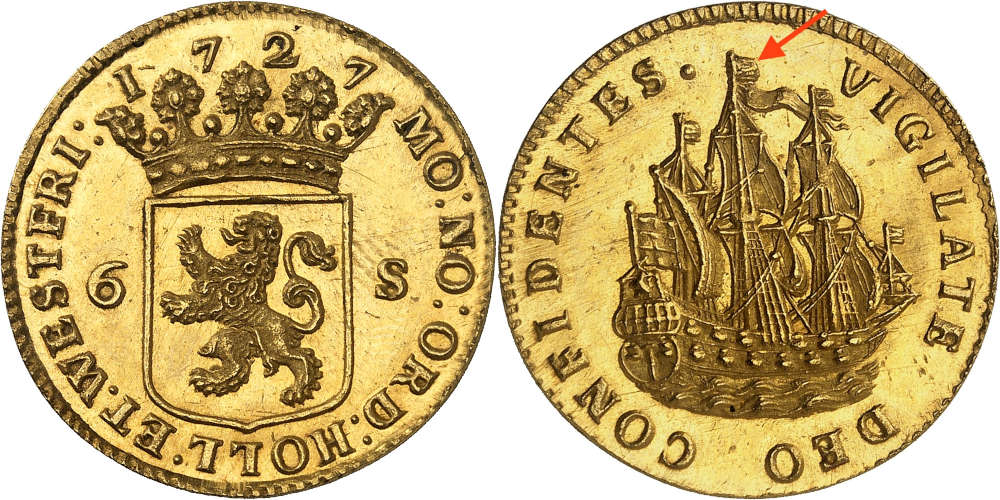
Netherlands / Holland and West Frisia. Off-metal strike in gold of 2 ducats from the dies of the 1727 scheepjesschelling, Dordrecht. Very rare. Extremely fine to FDC. Estimate: 2,500 euros. From Künker 414 (27/28 September), No. 4384. While the flag at the stern shows the Prinsenvlag, you can see the bloody flag at the mast top.
Show Your Strengths
The ship with the bloody flag thus represented the greatest strength of the Netherlands: every single ship that was prepared to fight for its country. Although the inscription of the coin invokes God – it translates as “Remain vigilant, trusting in God” – the Dutch preferred to rely on their wooden vessels.
But Louis XIV was not interested in the sea. He invaded the Netherlands as early as in 1672, initially with great success. But the fleet prevented worse. Its victories gave Stadtholder Willem III the arguments and room for maneuver to take diplomatic action himself. In 1673, the Netherlands made a treaty with the Habsburg emperor and the King of Spain against Louis XIV. This forced Louis XIV to fight a costly war on several fronts. Only a year later, England withdrew from the war due to the high economic damage caused by Dutch ships. In 1678, with the Treaties of Peace of Nijmegen, the Dutch were the big winners. Not only did they get all their territories back. Louis XIV also wooed them with a trade treaty that abolished all customs duties for them in his empire.
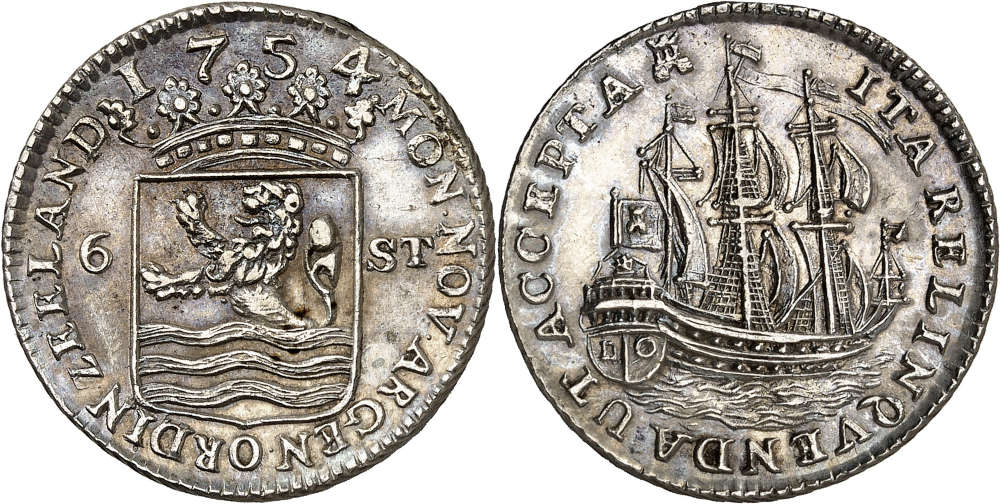
Netherlands / Zeeland. 1754 piedfort of a scheepjesschelling (6 stuivers), Middelburg. Rare. Extremely fine. Estimate: 250 euros. From Künker 414 (27/28 September), No. 4676.
Many Different Flags
By this time, the coin type of the scheepjesschelling had already established itself on foreign markets as a popular trade coin, regardless of its political message. As a result, others were soon minting coins following the model of the scheepjesschelling. Therefore, we find a wide variety of flags on later issues.
The piedfort shown here presents a slightly modified form of the bloody flag. The cutlass was replaced by the coat of arms of Middelburg. As the Maritieme Musea describes in its online catalogue, the various cities added identification marks to the bloody flags of their ships so that others would even know during a battle where the ship came from. Ships from Vlissingen also used a bloody flag. The flag depicted the Jacoba jug in the form that can still be seen on the city’s coat of arms today.
The “bloody flag” recalls a basic rule of numismatics: you have to look very carefully if you want to tell the exciting story of a coin. Another basic rule is that you do not have to be rich to acquire fascinating objects. Estimates for the scheepjesschellings in the Beuth Collection start at 50 euros.





